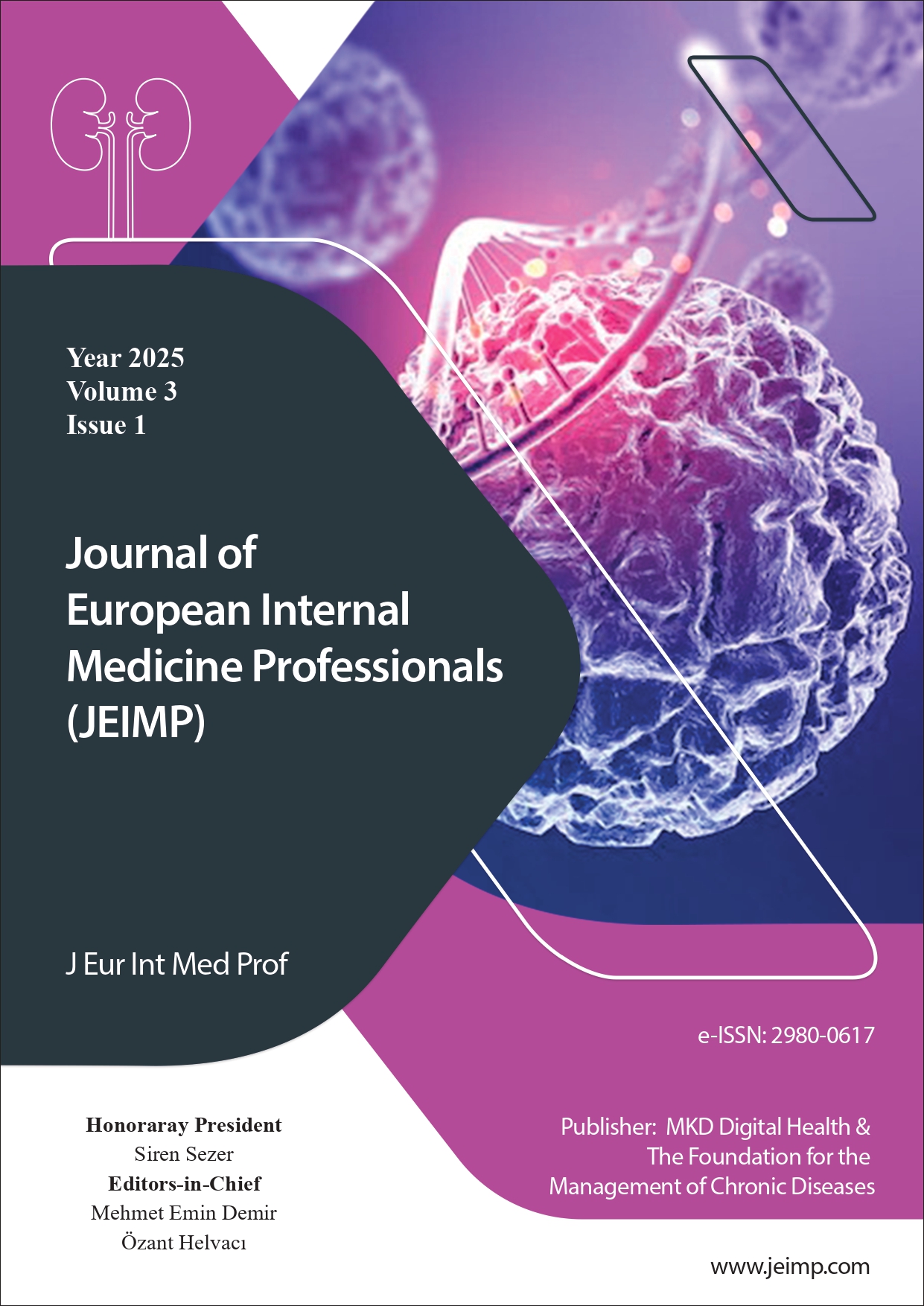Relation Between nt-ProBNP and Serum Sodium Based on Glomerular Filtration Rate
NT-proBNP and Sodium
DOI:
https://doi.org/10.5281/zenodo.14692905Keywords:
Heart Failure, Chronic Kidney Disease, Natriuretic Agents, SodiumAbstract
Background: Electrolyte imbalance and volume overload are common in chronic kidney disease and heart failure. We aimed to evaluate the relationship between serum sodium and N terminal pro-brain natriuretic peptide (NT-proBnp) based on estimated glomerular filtration rates in heart failure (HF) patients with low ejection fraction.
Methods: A total of 389 patients aged 18-80 years who presented to our hospital with symptoms of heart failure were included in the study. Demographic, laboratory, and echocardiography findings were recorded. The study group consisted of patients with ejection fraction (EF) less than 55% and estimated glomerular filtration rate (eGFR) less than 90mL/min, and subgroups were formed according to eGFR, ejection fraction and NT-proBnp level.
Results: Of the total group, 54.5% were female, and the median age was 64 (IQR18) years. Age, NT-ProBnp, creatinine, BUN, and CRP were significantly (p<.05) higher in the study group compared to the control group. When subgroups were compared according to eGFR, age, creatinine, NT-proBnp, BUN, and CRP were significantly (p<.05) higher in the group with eGFR<45mL/min compared to the group with eGFR=45-89mL/min. In the group with NT-proBNP above 6000, it was seen that eGFR, EF, sodium, albumin, and hematocrit were effective at a rate of 38.4% in the multivariate logistic regression model.
Conclusion: In HF and low eGFR, NT-proBnp increases with volume increase. In light of the data that NT-proBnp, which is known to be released from stress-induced cardiomyocytes, is excreted and metabolized via the renal route, renal function should be taken into consideration in the interpretation of NT-proBnp elevated levels.
References
McDonagh TA, Metra M, Adamo M, et al. Corrigendum to: 2021 ESC Guidelines for the diagnosis and treatment of acute and chronic heart failure: Developed by the Task Force for the diagnosis and treatment of acute and chronic heart failure of the European Society of Cardiology (ESC) With the special contribution of the Heart Failure Association (HFA) of the ESC. Eur Heart J. 2021;42(48):4901. doi:10.1093/eurheartj/ehab670
Belagavi AC, Rao M, Pillai AY, Srihari US. Correlation between NT proBNP and left ventricular ejection fraction in elderly patients presenting to emergency department with dyspnoea. Indian Heart J. 2012;64(3):302-304. doi:10.1016/S0019-4832(12)60091-1
DeFilippi C, van Kimmenade RR, Pinto YM. Amino-terminal pro-B-type natriuretic peptide testing in renal disease. Am J Cardiol. 2008;101(3A):82-88. doi:10.1016/j.amjcard.2007.11.029
Tsai YC, Tsai HJ, Lee CS, et al. The interaction between N-terminal pro-brain natriuretic peptide and fluid status in adverse clinical outcomes of late stages of chronic kidney disease. PLoS One. 2018;13(8):e0202733. Published 2018 Aug 22. doi:10.1371/journal.pone.0202733
Arjamaa O. Physiology of natriuretic peptides: The volume overload hypothesis revisited. World J Cardiol. 2014;6(1):4-7. doi:10.4330/wjc.v6.i1.4
Novak JE, Ellison DH. Diuretics in States of Volume Overload: Core Curriculum 2022. Am J Kidney Dis. 2022;80(2):264-276. doi:10.1053/j.ajkd.2021.09.029
Adrogué HJ. Hyponatremia in Heart Failure. Methodist Debakey Cardiovasc J. 2017;13(1):40. doi:10.14797/mdcj-13-1-40
Lim LM, Tsai NC, Lin MY, et al. Hyponatremia is Associated with Fluid Imbalance and Adverse Renal Outcome in Chronic Kidney Disease Patients Treated with Diuretics. Sci Rep. 2016;6:36817. Published 2016 Nov 14. doi:10.1038/srep36817
Bunnag S, Pattanasombatsakul K. N-terminal-pro-brain natriuretic peptide for the differential diagnosis of hypovolemia vs. euvolemia in hyponatremic patients. J Med Assoc Thai. 2012;95 Suppl 3:S69-S74.
Caraba A, Iurciuc S, Munteanu A, Iurciuc M. Hyponatremia and Renal Venous Congestion in Heart Failure Patients. Dis Markers. 2021;2021:6499346. Published 2021 Aug 12. doi:10.1155/2021/6499346
Khan S, Floris M, Pani A, Rosner MH. Sodium and Volume Disorders in Advanced Chronic Kidney Disease. Adv Chronic Kidney Dis. 2016;23(4):240-246. doi:10.1053/j.ackd.2015.12.003
Maries L, Manitiu I. Diagnostic and prognostic values of B-type natriuretic peptides (BNP) and N-terminal fragment brain natriuretic peptides (NT-pro-BNP). Cardiovasc J Afr. 2013;24(7):286-289. doi:10.5830/CVJA-2013-055
Hall C. NT-ProBNP: the mechanism behind the marker. J Card Fail. 2005;11(5 Suppl):S81-S83. doi:10.1016/j.cardfail.2005.04.019
Levey AS, de Jong PE, Coresh J, et al. The definition, classification, and prognosis of chronic kidney disease: a KDIGO Controversies Conference report [published correction appears in Kidney Int. 2011 Nov;80(9):1000] [published correction appears in Kidney Int. 2011 Nov 1;80(9):1000. doi: 10.1038/ki.2011.310]. Kidney Int. 2011;80(1):17-28. doi:10.1038/ki.2010.483
Borg R, Carlson N, Søndergaard J, Persson F. The Growing Challenge of Chronic Kidney Disease: An Overview of Current Knowledge. Int J Nephrol. 2023;2023:9609266. Published 2023 Mar 1. doi:10.1155/2023/9609266
Dhondup T, Qian Q. Acid-Base and Electrolyte Disorders in Patients with and without Chronic Kidney Disease: An Update. Kidney Dis (Basel). 2017;3(4):136-148. doi:10.1159/000479968
Urso C, Brucculeri S, Caimi G. Acid-base and electrolyte abnormalities in heart failure: pathophysiology and implications. Heart Fail Rev. 2015;20(4):493-503. doi:10.1007/s10741-015-9482-y
Rodriguez M, Hernandez M, Cheungpasitporn W, et al. Hyponatremia in Heart Failure: Pathogenesis and Management. Curr Cardiol Rev. 2019;15(4):252-261. doi:10.2174/1573403X15666190306111812
Pereira-Barretto AC, de Oliveira MT Jr, Strunz CC, Del Carlo CH, Scipioni AR, Ramires JA. O nível sérico de NT-proBNP é um preditor prognóstico em pacientes com insuficiência cardíaca avançada [Serum NT-proBNP levels are a prognostic predictor in patients with advanced heart failure]. Arq Bras Cardiol. 2006;87(2):174-177. doi:10.1590/s0066-782x2006001500016
Linssen GC, Damman K, Hillege HL, Navis G, van Veldhuisen DJ, Voors AA. Urinary N-terminal prohormone brain natriuretic peptide excretion in patients with chronic heart failure. Circulation. 2009;120(1):35-41. doi:10.1161/CIRCULATIONAHA.108.824581
Portolés J, Martín L, Broseta JJ, Cases A. Anemia in Chronic Kidney Disease: From Pathophysiology and Current Treatments, to Future Agents. Front Med (Lausanne). 2021;8:642296. Published 2021 Mar 26. doi:10.3389/fmed.2021.642296
Nerpin E, Ingelsson E, Risérus U, et al. The association between glomerular filtration rate and left ventricular function in two independent community-based cohorts of elderly. Nephrol Dial Transplant. 2014;29(11):2069-2074. doi:10.1093/ndt/gfu199
Arzhan S, Lew SQ, Ing TS, Tzamaloukas AH, Unruh ML. Dysnatremias in Chronic Kidney Disease: Pathophysiology, Manifestations, and Treatment. Front Med (Lausanne). 2021;8:769287. Published 2021 Dec 6. doi:10.3389/fmed.2021.769287
Bianchi S, Aucella F, De Nicola L, Genovesi S, Paoletti E, Regolisti G. Management of hyperkalemia in patients with kidney disease: a position paper endorsed by the Italian Society of Nephrology. J Nephrol. 2019;32(4):499-516. doi:10.1007/s40620-019-00617-y
Guglin M, Darbinyan N. Relationship of hemoglobin and hematocrit to systolic function in advanced heart failure. Cardiology. 2012;122(3):187-194. doi:10.1159/000339536
Willis MS, Lee ES, Grenache DG. Effect of anemia on plasma concentrations of NT-proBNP. Clin Chim Acta. 2005;358(1-2):175-181. doi:10.1016/j.cccn.2005.03.009
Downloads
Published
How to Cite
Issue
Section
Categories
License
Copyright (c) 2025 Muhammed Emir İnce, Semahat Karahisar Şirali, Mehmet Fatih Bulucu, Ahmet Çorakcı

This work is licensed under a Creative Commons Attribution 4.0 International License.










